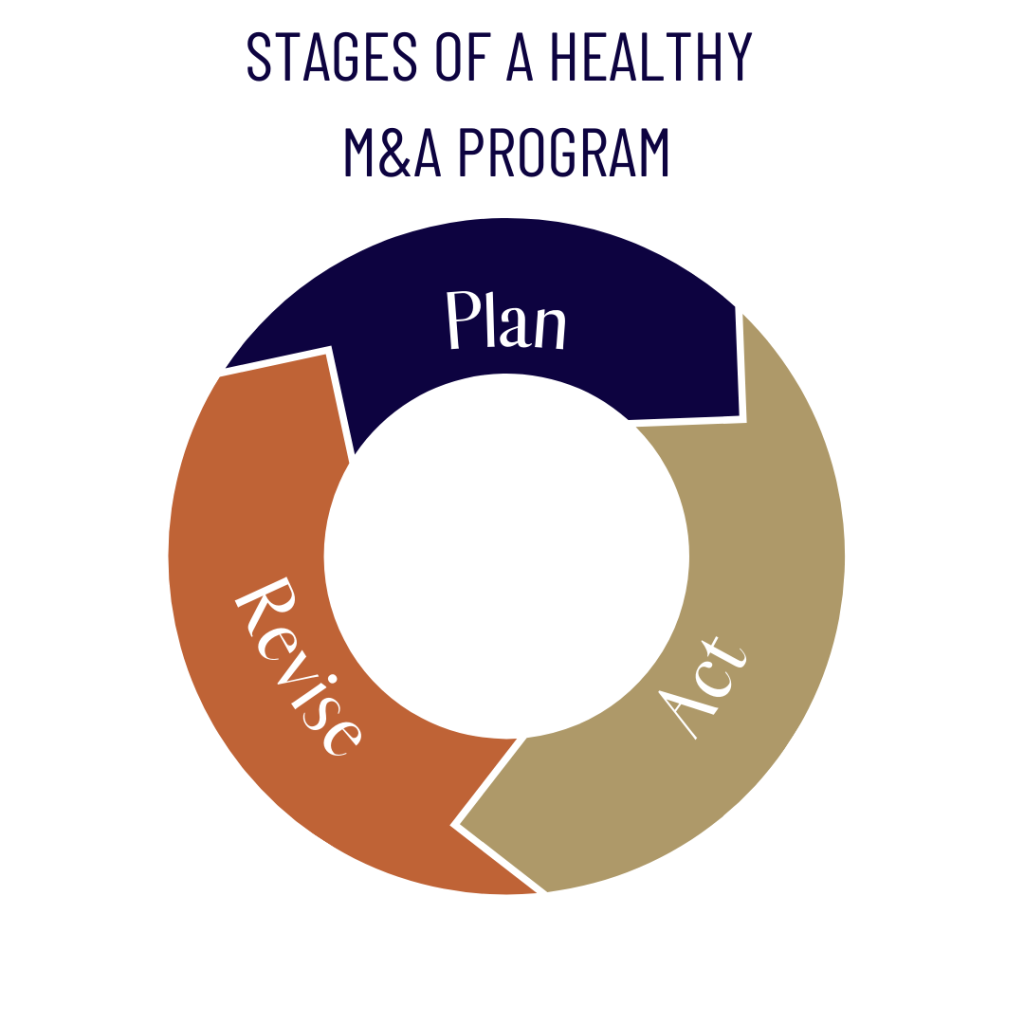There’s a quote I love from the great Mike Tyson: “Everyone has a plan until they get punched in the mouth.” It resonates with me because I know first-hand that even your best-laid plan will get punched—or even knocked out cold—as you execute it. For many merger and acquisition (M&A) leaders, the challenge (and the opportunity) is learning how to get back up. This is where a problem-solving framework can make a huge difference.
Over the past few months, I’ve shared my thoughts on why backing up strategic planning with intentional action is critical to achieving the results you want. As your leadership team develops its strategy-execution muscle, it must also be ready to address the challenges that inevitably arise.
Having a solid problem-solving framework to work through these challenges can not only help you make faster and smarter decisions in the moment, but it can also mean the difference between the success and failure of your programmatic M&A strategy.
Solving Problems Through Action

Building the momentum it takes to close deals requires three steps: planning, acting, and revising. Let’s start by reviewing the key elements of each of these steps:
- Plan: Document where you want to go and the assumptions that underpin the actions, events, and scenarios that’ll get you there. The key here is not to get too bogged down—plan, but don’t let planning become all you do.
- Act: These are the deliberate tasks that move the ball down the field—or stop the play entirely. But it isn’t always smooth sailing. Action will produce two events:
Successes: Acknowledge your successes and how they validate the assumptions you made in your plan.
Challenges: Drill down to identify which assumptions were wrong, or which changes contributed to the problem. This is where the problem-solving framework comes in (more on that further down). - Revise: Actively manage and revise your plan as the action unfolds. The best-laid strategic plans are dynamic, not static.
Let’s spend some time with that third phase: Revise. As M&A leaders, we know that execution doesn’t always go as planned. This is just the nature of building a dynamic M&A program. Maybe a few of your assumptions about ideal acquisitions were off-base. Maybe your team’s actions didn’t impact your bottom line. Maybe circumstances outside of your control changed the business cycle your acquisition strategy is based on.
The true measure of your success, though, isn’t whether you face challenges. It’s how you face them—and then how successfully you transition from action to revision. Doing so will require you to become a good problem solver.
Problem Solving Framework
Problem-solving is a skill you practice until your problem-solving muscle is as strong as you need it to be.
Before I share my framework and an example of how you can put it into action, let me say this: problem-solving is a skill you practice until your problem-solving muscle is as strong as you need it to be. I’ve worked with countless M&A leaders on solving the challenges they face, and I’ve found that there are generally nine steps that lead to the strongest solutions:
Step 1: Define the Symptom. What is being felt? Where is the friction?
Step 2: Define the Problem. What is the root cause of the symptom?
Step 3: Define the Who. Who needs to take responsibility for solving the problem?
Step 4: Leverage the Data. Collect and analyze data to support your hypothesis about the root cause and inform possible solutions.
Step 5: Brainstorm Possible Solutions. Get creative and think about the best way to solve the problem.
Step 6: Prioritize, Prioritize, Prioritize. Make sure you prioritize the steps needed to tackle the problem.
Step 7: Scenario Planning. Plan for all of the different outcomes and be ready for next steps.
Step 8: Take Action. The most important part: execute and ensure accountability around execution.
Case Study Example
The Set Up
Let’s imagine you are a business owner running a HVAC company generating $20 million in revenue. You have decided you would like to grow through strategic mergers and acquisitions, and you decide to take it upon yourself to drive this growth strategy.
The Scenario
You start by reaching out to some business brokers and investment banks you know to ask them about any companies that they know of that might be a good fit for you. They always say the same thing: that they will “keep you in mind.” You also spend some time calling a few companies you have a good relationship with to inquire if they are ready to sell. They say not yet but that they’ll “keep you in mind.” You have spent 3 months, you feel like you are doing everything you can to drive activity, but nothing is happening.
Let’s run this scenario through our problem-solving framework:
(1) The Symptom
The phone is not ringing, you don’t have any ongoing meaningful conversations, and you start getting discouraged.
(2) The Problem
Clearly defining the root cause of your symptom is crucial but can be the most challenging step. Let’s start by ruling out a couple options:
First, we know the problem is not your level of desire to grow through M&A. The fact that you’ve given so much of your time already to executing this strategy is evidence of that.
Second, we can be pretty confident that the problem is not the market. You can find evidence for this simply through monitoring deal flow across the industry—others are having success where you’re not.
So what is the root cause? Odds are it’s one of these:
- No strategic M&A plan. Not having a defined plan dilutes your focus and minimizes the effectiveness of your outreach.
- Lack of capacity. You don’t have the bandwidth to systematically follow-up on daily/weekly outreach to drive relationships forward and seed deals.
- Insufficient time invested. Three months may simply not be enough time to truly measure the effectiveness of the strategy overall (i.e., you haven’t been at it long enough.).
(3) The Who
As the owner of your business and the decision-maker driving this strategy, this problem is yours to own.
(4) Leverage the Data
You look back and realize you weren’t tracking your activity (the calls, meetings, conversations etc) so you don’t have much in the way of data to help you with uncovering a solution to the problem. However, you have a gut instinct that this growth initiative requires much more intentional time and effort than you have to give it, given your other responsibilities as a business owner. Remember: your gut instinct is still data; it’s just not measurable.
(5) Brainstorm Possible Solutions
You do a whiteboard session on all the ways you might be able to solve the problem and you come up with three viable solutions:
- Have someone on your internal team step up to do this work
- Delegate more of your other responsibilities and dedicate more of your time to M&A
- Hire or contract with someone to specifically focus on this workstream
(6) Prioritize, Prioritize, Prioritize
Now it’s time to narrow down your list of three to just one best solution. You start by acknowledging that you don’t have anyone internal who has the capacity or expertise to do this work, so you strike #1 off your list. Similarly, your team is lean, and you don’t think you can reasonably ask someone to take on your other responsibilities—particularly around leadership. There goes #2.
You conclude that hiring someone to drive these results is your best answer. Now, you need to shift your focus on spending your time on recruiting and an onboarding plan and prioritize these activities.
(7) Scenario Planning
Now that you have prioritized hiring, think about all of the scenarios that could play out with contingency plans. For example, if your first instinct is to go out and hire someone full-time at a $150k salary with bonus, prepare for the possibility that you might not be able to locate this resource on your timeline and within your budget. Think through your Plan B – what action would you pivot to, and what key indicators would you be looking out for to signal the need for this pivot?
(8) Take Action
Now that you have all the scenarios mapped out, get out there and make it happen. Be ready to pivot as you gather more information.
The Biggest Problem-Solving Mistakes Leaders Make
It’s important that you work to avoid mistakes that can grow into toxins in your organization.
Now, that eight-step problem-solving framework isn’t a silver bullet. How successful it is depends on how well you apply it. On their path to getting good, I see many leaders stumble because they:
- Take the easy way out: I’ve learned that the easy way usually isn’t the right answer. Instead, use the data you collect and your continuous feedback loop to do the work viable solutions require—even if the execution demands a little more effort.
- Treat the symptom, not the cause: Make sure your solutions address the root cause. Too many leaders focus on treating the symptom, which doesn’t produce long-term results and can even introduce more challenges.
- Do nothing: Problem-solving is hard, so many leaders hope the problem will solve itself—and it usually doesn’t. To achieve, you have to act.
While these mistakes are common, they’re also avoidable. And it’s important that you work to avoid them, because when you don’t, they can grow into toxins in your organization—creating foundational weight that stifles growth and keeps you and your team from maturing to the next level.
Ready to get started?
Solving problems is what will separate the good leaders from the great ones. But learning how to problem solve takes time, and it isn’t always easy to learn on your own. If you’re struggling to overcome the many challenges on the M&A journey, G-Spire can help you:
- Assess your business infrastructure
- Create a focused and disciplined investment strategy
- Work through the problem-solving framework to unlock growth
- Develop feedback loops to strengthen your process
Let’s get started!
About the G-Spire Group
The G-Spire Group helps entrepreneurs looking to grow through acquisition identify potential targets, negotiate with sellers and integrate the newly purchased business into their portfolio. To learn more, please visit: https://www.gspiregroup.com/

